How To Add Contrast To Your Decor
Contrast has transformative power in your home! It can create interest and beauty. Learn how to use this easy, essential interior design principle to create a room you will love to spend time in.
Every home decorator should know and use contrast in decorating. Contrast is an important interior design principle that creates visual interest, harmony, and beauty! Think of contrast as the yin and yang of decorating. Contrast just might be the missing element that would take a room in your home to the next level. And it’s so easy to learn and use!
This post is part of a series called DECORATING SCHOOL. I’ve compiled a decorating course to help you become a more confident home decorator. You can decorate! You can create a home that is comfortable and beautiful, and that reflects your unique personal style. I’ll show you how!
Ready to use contrast in your home?
My superpower is breaking down interior design concepts into easy-to-understand, doable, and repeatable processes. So, let’s break down the concept of contrast in decorating so we can use it in our homes!
What Is Contrast, And Why Is It Important
Here is a good working definition of contrast…
Contrast is arranging items with different or often opposite characteristics together in a room to create impact. It’s that easy!
And when we talk about contrast in decorating, we are talking about one of the most important ways to create an interesting home!
Our eyes pick up this contrast without us even knowing it, and if there is enough contrast in a room, our brains find that room so interesting, and exciting things read as attractive!
When things in a room are all the same, they are usually not attractive to us. Same color, same size, same shapes, no contrast. And no wonder. One of the easiest ways to create interest in a room is to use lots of contrast.
What Makes A Room Attractive
We talk about the eye/mind connection a lot here at StoneGable. There are elemental interior design concepts that are essential to know to make decorating make sense. And make decorating a lot easier, too.
When contrast is used correctly in a room, the visual impact is profound. I like to call this the WOW factor!
Using sound interior design concepts will make a room and a home more visually pleasing and comfortable. Contrast is one design concept you will want to know how to use! Without contrast, we miss out on one of the critical elements that create a lovely and fascinating room.
And honestly, contrast is an easy element of design to add to a room!
Most Common Types Of Contrast
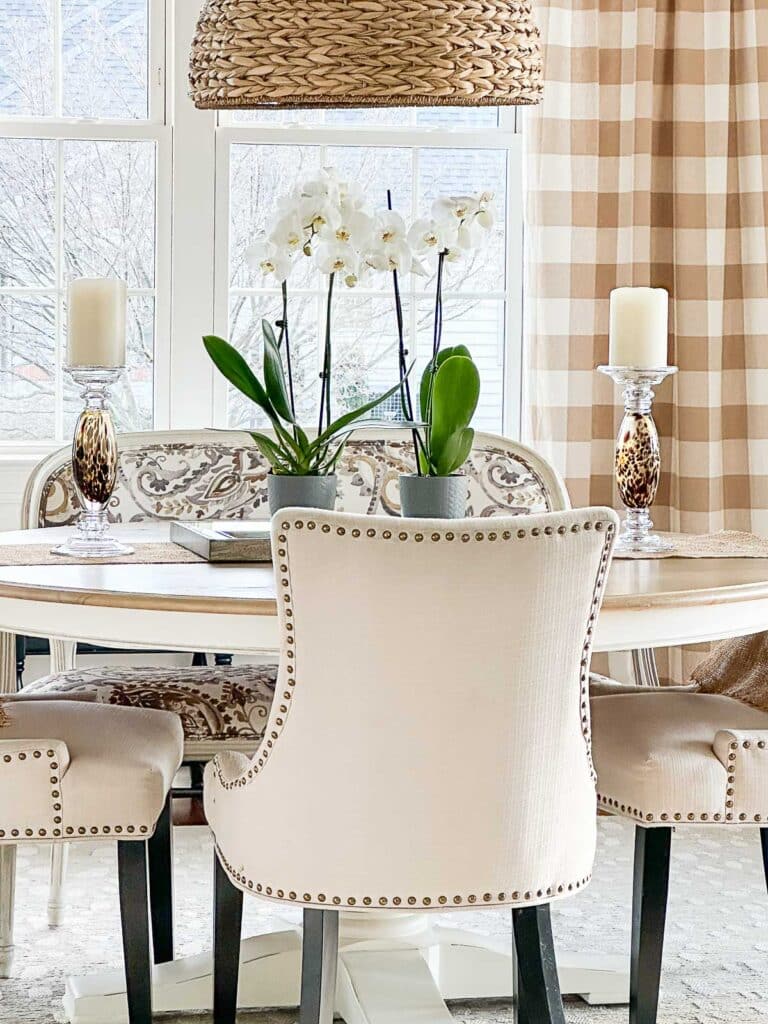
Today, let’s look at some of the most common types of contrast, which we can use to create fabulous living spaces!
Color
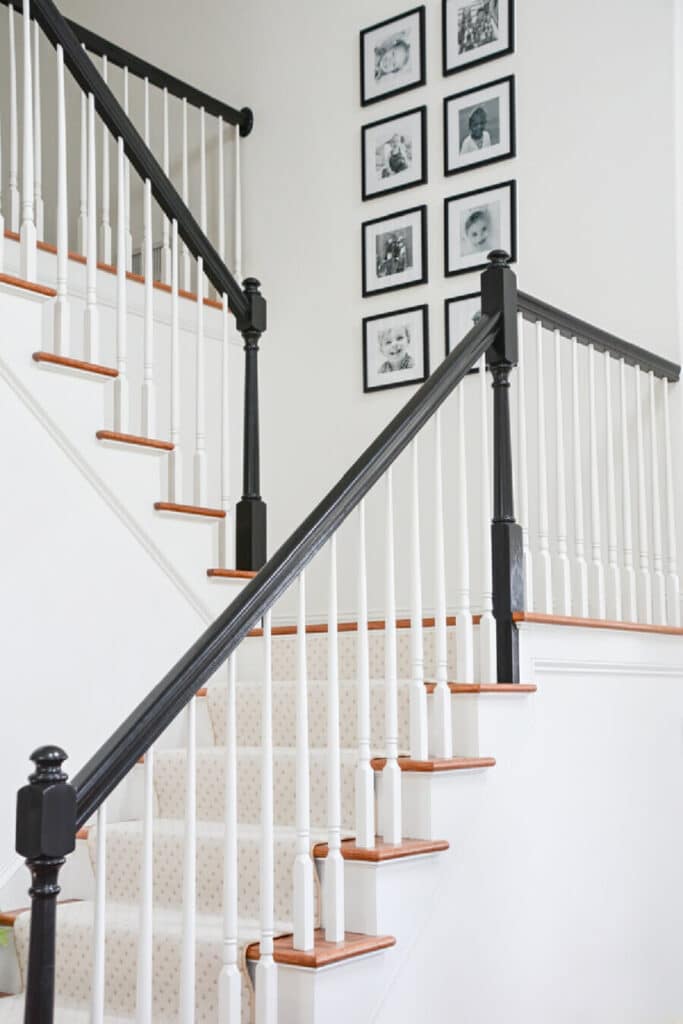
One of the most accessible contrasts to add to our homes is color. Think of how stunning black and white rooms look! That, my friend, is a contrasting color combination. Black and white is dramatic and is a striking contrast and feels sophisticated. It is because we noticed the color difference right away, and it looked impressive to us!
Light and dark color combinations create such a high contrast! Using a complementary color scheme from the opposite sides of the color wheel is another way to add contrast to a room.
These colors put together in a room create high contrasts…
- red and green
- purple and yellow
- blue and orange
Just a word of caution here! If you love color and use complementary colors to create contrast, one color must be the dominant color and the other color the accent. One color should only be used as the POP of color, while the other complementary color can be used more liberally throughout a room. The tension and balance of these colors, done in the right amounts, create beauty in a room.
Color has a significant effect on us. Use a color palette that creates a welcoming, comfortable place to spend time
Mastering The Art Of Choosing The Perfect Color Palette is a great resource to help you.
High/Low Contrast
This is such an easy way to add artistry and elegance to a room. I’ve been using the high/low contrast for years.
Mixing high-end or luxury-looking furnishings with ordinary, utilitarian, or everyday items creates a distinct juxtaposition that is bound to be noticed! The contrast is quite apparent and creates lovely aesthetics.
The organic wooden beads and the burlap book are juxtaposed with the chic white bowl above. This is a simple example of the high/low contrast that makes us take a second look.
It’s that old adage of opposite attractions! A beautifully upholstered chair with a straw hat tossed on it. A velvet blanket and a burlap pillow. A crystal goblet holding paper straws!
This high/low mix is charming, startling, and unusual! It is also a pretty and savvy way to add contrast to a room in your home.
Contrasting Home Decor Finishes
Another way to create contrast is by incorporating opposing elements with various finishes in your home. It’s no surprise that matte finishes on walls complement high gloss woodwork so well. Introducing different finishes within a room adds visual appeal and depth compared to sticking with a single finish.
For example, if brass fixtures dominate your bathroom, the principle of contrast suggests adding a few accessories in different metals to enhance visual interest. A room filled with matching materials can lack excitement. Opting for contrast brings a room to life and adds personality to your space.
Textural Contrast
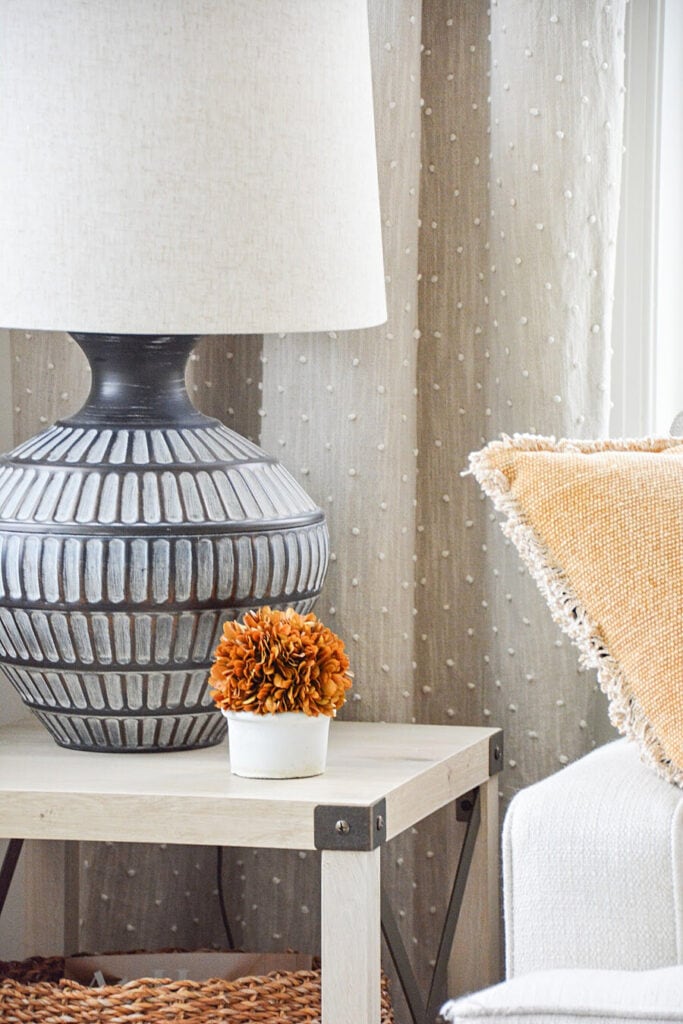
This is the number one way I add contrast to my neutral home.
We can actually feel something when we see it. Our brain can perceive rough, lofty, shiny, smooth, gravely, bumpy, silky, complex, slimy, wet, dry, and so much more!
We should have a mix of textures in our homes—bumpy, soft, rough, smooth—all mixed into a room because our eyes are crazy about texture. Without evaluating the texture of a room, our minds can get very bored! Just think how pretty an oriental rug looks on a hardwood floor or a velvet pillow on a wooden chair. Beautiful texture and contrast!
If you have a neutral palette in your home, you especially need texture! I’m very aware that texture keeps my home exciting and takes the place of lots of colors!
You might also like 7 TIPS FOR DECORATING WITH NEUTRALS.
Contrasting Shapes
Our eyes and minds are always trying to make sense of what they see, and one big way they do this is by looking for repeated elements in a room.
By looking for the same shapes, our eyes zip around the room, which is precisely what we want our eyes to do! When they bounce around the room looking for repeated things like shapes, our minds see this as attractive because they can make sense of the room through repeated shapes, colors, textures, and more.
However, like most things in decorating, there is a balance. If everything in a room is the same, our eyes can also get bored and read this as uninteresting! Fickle eyes, right?
So, it is smart to repeat shapes in a room, and it is even smarter to add a different shape! A round mirror is a joy to add to a room full of rectangle furnishings! Smart decorating!
Mixing And Matching
There is also contrast in mixing and matching other things as well.
Here are just a few…
- patterns and textiles
- positive and negative space
- metal finishes in a room
- more than one style of furniture
- a variety of plants and flowers
How To Use Contrast In Your Home
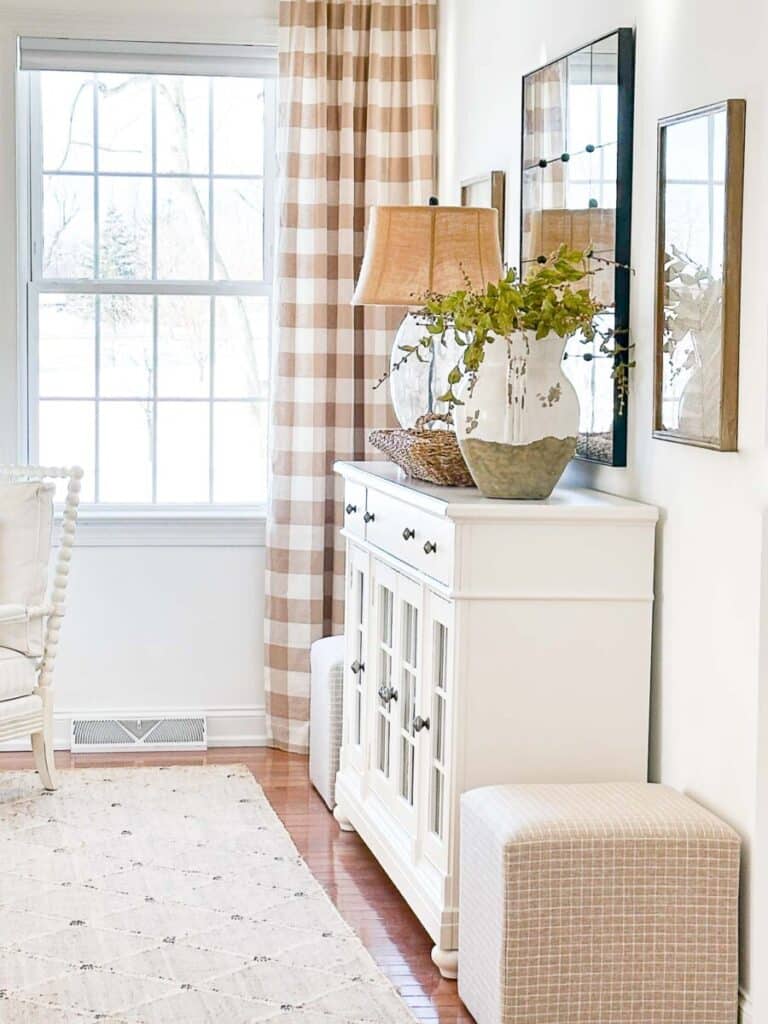
Now that you know what contrast is, let’s discuss using it in your home.
Every room in your home needs contrast. The more similar the things in a room are, the more contrast you should add. If a room already has a lot going on in it, you can probably bet it already has some contrast.
Every room does not need to use every type of decorating contrast, though. Start by being aware of what your room might need most.
My home is very neutral, so it needs lots of texture! It also has many boxy-shaped furnishings, so it needs a few round or softer-shaped items.
Really pay attention to using a pop of color in a room and different metals on drawer pulls, curtain rods, and nailheads on furniture. Think about ways to introduce a high/low mix of items. Just used an edited hand. A little goes a long way.
Using contrast when you decorate can transform a room from ordinary to extraordinary. By thoughtfully combining colors, textures, patterns, and styles, you can create an attractive and cohesive room or home that reflects your personal taste and style.
Remember, balance is the key—too much contrast can overwhelm a room, while too little can come across as boring. Experiment with different elements and find the perfect blend that suits your space and style.
Ready to elevate your home’s decor with contrast? Start small and see the big impact it can make! Share your favorite contrast decorating tips and tricks in the comments below. Let’s create beautiful spaces together!
FAQs About Texture
Happy Decorating, Friends!
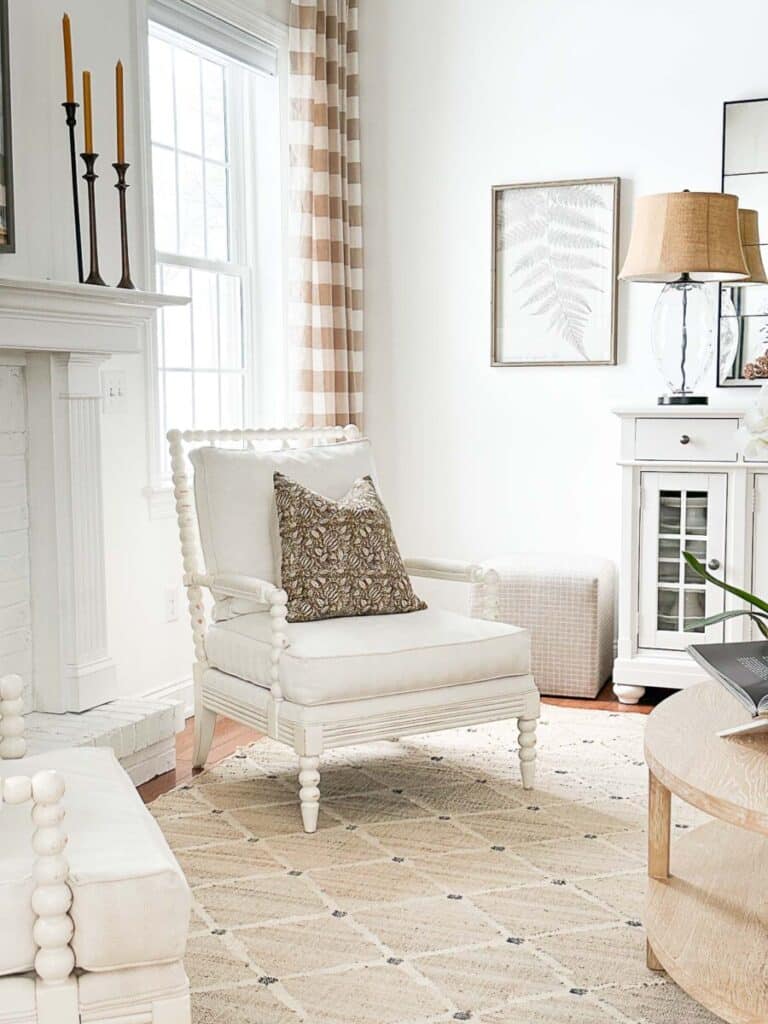
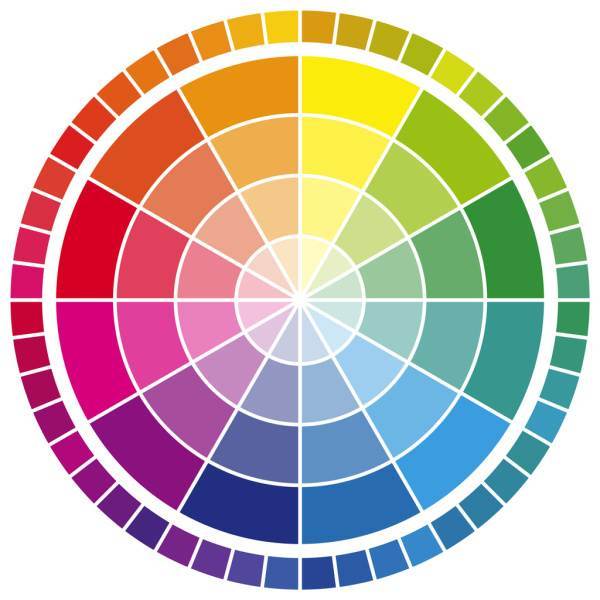



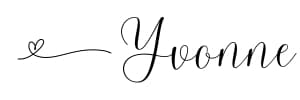



Yvonne, This is my absolute favorite tool to use in my home and my art! Great article!
Thanks, Kat! Contrast is so important! It’s a great design element to learn and use.
Wow – your last few posts have been like a decorating tutorial. I love the contrast between rustic and refined. Your example of a silver punch bowl placed on a wooden cutting board is exactly what I did in my kitchen. I think it’s a real statement on our personalities – for example, a little bit country and a little bit rock and roll!
LOL! I got a kick out of your last sentence. You are so right Lyn!
Good Morning……..Thank You I am leaning and like the lady said a little bit country and I little bit rock and roll…..
LOVE that! So glad you are learning, Eva! We all are.
Yvonne, I love to use my phone to take pictures of my rooms to see what looks right and what looks wrong. Texture and repetition of shapes are two ways I like to make a room interesting. I also like to add a little black to my rooms and find it great with my neutral color scheme. Prayer coffee and your blog each morning start my day out right. Bless you.
LOVE your morning combination, Kathy! Thanks! And yes you are so right about your decorating tips.
Hi Yvonne,
I have learn so much from you! Thanks to you, I feel like my home has finally grown up!
I love your new mirror. It looks fantastic! What size did you order?
Hope you have a great day!
Linda
I ordered the largest size. I’m thrilled StoneGable is helping you! That is my goal.
I have lighter oak kitchen cabinets, but am interested in getting a darker(with hints of light in it) dining room table which is right next to the kitchen. Is that okay to do? It is a sort of contrast?
Contrast is a very good thing. Just watch the undertones of each piece of wood. They should not fight each other. See this helpful post:https://www.stonegableblog.com/can-you-mix-warm-and-cool-colors-in-decor/
I love your home! Where do you shop for curtains? ❤️
My favorite place to shop for curtains is Ballard Designs. They are pricy but they are gorgeous and so well made! Worth every penny.
I learned contrast this through trial and error. Now I know it’s an actual thing and has a name! I will look to do it more often. Thank you for your great tips and advice!
Good for you, Susan.